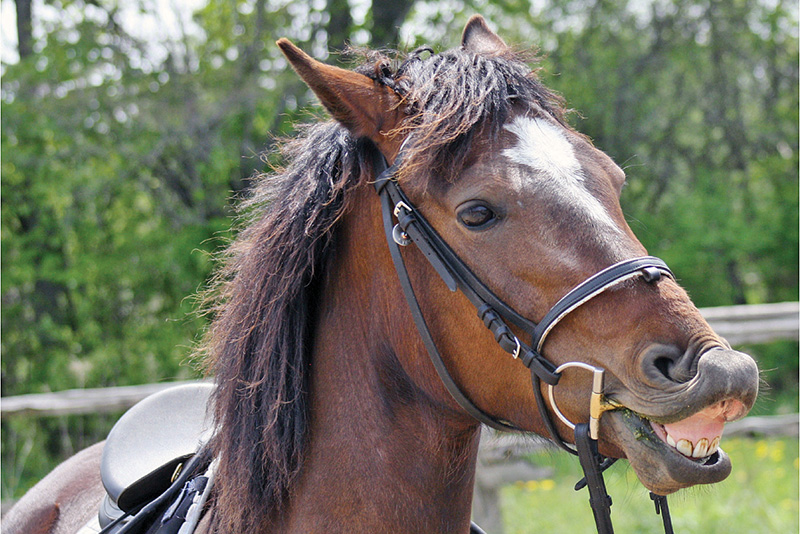In this photo by just looking at the top incisors we can tell that Skitchy is around 4 ½ years old. We can see she has all of her permanent incisors (the corner permanent incisors are just erupting). The teeth are still quite round, and her bite angle is close to 90 degrees. Courtesy Photo
By Caylyn Walker
AgriNews Contributor
When a horse is registered, the person registering the horse (typically the breeder) will mark down when the horse was born on the registration papers. This makes a fool proof way to determine the age of a horse, but not all horses are registered or sometimes horses are separated from their registration papers when transferred to new homes, and it can become a bit of mystery how old the horse actually is.
Aging a horse by its teeth may seem unlikely, but it is one of the best methods for determining how old a horse might be. Outside factors such as abnormal teeth wear from things like cribbing or injuries to the mouth like a kick may affect the accuracy of the teeth reading, but overall looking at the teeth is a common practice in determining a horse’s age.
Age is determined by looking at the 12 incisors at the front of the horse’s mouth. A horse has 6 incisors on the top of their mouth and 6 on the bottom. Young horses are the most accurate to age based on the eruption of baby teeth, loss of baby teeth and then the eruption of permanent teeth. The first two teeth to erupt on a horse are the very front two incisors on the top and bottom jaw. These erupt shortly after birth (usually in the first 10 days). At around 4 weeks of age the foal will have 4 incisors on the top and bottom jaw as the next front teeth emerge. When the foal is 9-12 months of age it will have its full set of incisors with 6 on the top jaw and 6 on the bottom jaw.
Around 2 ½ years old the horse will start to erupt its first permanent incisors. The pattern of permanent teeth erupt follows the same pattern as the eruption of the baby teeth. The first permanent incisors to erupt will do so in the very front of the horse’s mouth. The horse will have two on the top jaw and two on the bottom. By 3 ½ years old the horse will have erupted the next set of permanent teeth and will now have 8 of its 12 adult incisors. At this point of time the horse will also have all 6 of its permanent adult premolars in place and 8 of the 12 adult molars. It is not unusual during this time to find a tooth that your horse may have lost. This is not a cause for concern as just as people, the baby teeth will fall out as the permanent adult teeth erupt.
By 4 ½ years old the horse will have all its permanent adult incisors and all its adult molars and pre-molars. Because of the known eruption of teeth, aging a horse up to 5 years old can be done quite accurately. After 5 years of age other factors start to be taken into consideration.
The appearance and shape of wear on the teeth are useful to look at once the horse is over 5 years of age. A horse around 5 years of age will have a large oval wear surface on the biting surface of the incisor, within this oval bite surface is a dark oval which is called a cup. As the horse ages, the wear surface appearance of the teeth will change. The change in this surface happens similarly to the eruption order of the teeth except that the bottom jaw incisors change first. Around 6 years of age the cups will disappear from the bottom front incisors. At 7, the next two bottom incisors lose their cups and then at 8 years old the final two bottom incisors lose their cups.
By 7 years old the horse develops a hook called the 7-year hook that can be noted in the upper last incisors. This hook is developed from normal wear of the teeth but will start to disappear around 8 years of age.
Around 9 years old the cups of the top teeth also start disappearing. First the front teeth will lose their cups followed by the next set of front teeth losing their cups at 10 years old and finally the last remaining cups on the final incisors are lost around 11 years old.
The Galvayne’s groove will also be present around the gumline of a horse that is around 10 years old. This groove can be found on the corner incisor teeth. Around 15 years of age this grooveshould reach roughly halfway down these incisors and then by 20 the groove will extend the full length of the tooth. After 20 years old, the groove will begin to disappear from the tooth from the top down. By 25 years of age the groove should only be seen on the bottom half of the corner incisors and by 30 the groove will have disappeared.
The final pieces to look at when aging a horse by its teeth is to look at the bite angle of the incisors and the shape of the teeth. As the horse ages the bite angle will be more acute. In young horses we would expect to see a bite angle close to 90 degrees, but as a horse ages it will change to 160-180 degrees. The shape of the teeth will also change from round teeth to more triangle teeth to rectangular as the horse ages.













